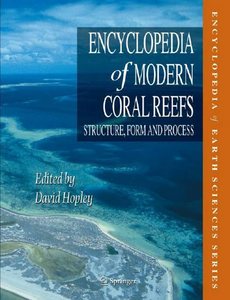Sea-level indicators
Smithers, Scott (2011) Sea-level indicators. In: Hopley, David, (ed.) Encyclopedia of Modern Coral Reefs: structure, form and process. Encyclopedia of Earth Science . Springer, Dordrecht, The Netherlands, pp. 978-991.
![[img]](https://researchonline.jcu.edu.au/19093/1.hassmallThumbnailVersion/19093_Smithers_2011_Book_Cover.jpg)
|
Image (JPEG) (Book Cover)
- Cover Image
Download (95kB) |
|
|
PDF (Published Version)
- Published Version
Restricted to Repository staff only |
Abstract
Sea level is the local height of the ocean's surface, usually measured to a datum referenced to a tidal position established from a record in which high-frequency motions such as wind waves and periodic changes (e.g., due to the tides) have been averaged out. Local sea level fluctuates regularly with tides and irregularly in response to factors including wind and currents, water temperatures and salinities, and atmospheric pressure.
Relative sea level is the elevation of the sea surface relative to the land at a given location. Global or eustatic sea-level fluctuations occur as the volume of water in the earth's oceans changes when ice caps and glaciers grow or melt, or as large-scale changes in the configuration of ocean basins and continental margins occur through plate tectonics. There are also regional and local isostatic processes that produce spatially different patterns of relative sea-level change, including thermal expansion of surface waters, changes in meltwater load, crustal adjustment of areas directly or indirectly affected by ice on- and offloading (see Glacio-Hydro Isostasy), coastal uplift or subsidence due to tectonic processes (see Earthquakes and Emergence or Submergence of Coral Reefs), and subsidence due to aquifer depletion or sediment compaction.
Sea-level indicators are used to determine relative sealevel changes at a location. Locating a sea-level indicator and determining its age and elevation relative to its modern counterpart can establish relative sea-level change. Sea-level indicators on coral reefs include a range of biological, geomorphological, sedimentological, and chemical features that provide information on the position of the sea surface at the time that they lived or were formed. They usually comprise features with a known relationship to a tidal position or datum.
| Item ID: | 19093 |
|---|---|
| Item Type: | Book Chapter (Research - B1) |
| ISBN: | 978-90-481-2639-2 |
| Date Deposited: | 18 Jan 2012 00:06 |
| FoR Codes: | 04 EARTH SCIENCES > 0406 Physical Geography and Environmental Geoscience > 040601 Geomorphology and Regolith and Landscape Evolution @ 100% |
| SEO Codes: | 97 EXPANDING KNOWLEDGE > 970104 Expanding Knowledge in the Earth Sciences @ 100% |
| Downloads: |
Total: 256 Last 12 Months: 7 |
| More Statistics |



